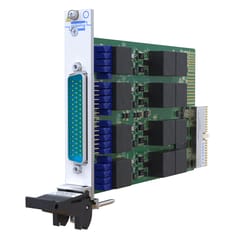-
PCI,cPCI,PXI & PXIe Instruments
- PCI,cPCI,PXI & PXIe Instruments
-
LXI Instruments
- LXI Instruments
-
RF & Microwave Instruments
- RF & Microwave Instruments
-
USB Instruments
- USB Instruments
-
Probe Station
- Probe Station
-
Breathalyzer
- Breathalyzer
-
Reed Relays
- Reed Relays
-
Software
- Software
- Home
- PCI,cPCI,PXI & PXIe Instruments
- Simulation Modules
- LVDT, RVDT, Resolver Simulator
LVDT, RVDT, Resolver Simulator
- 1 itemsIncrease test flexibility and reduce cost with our high-performance, high-density LVDT, RVDT, Resolver Simulator modules
New to our simulation product range is our PXI LVDT, RVDT, Resolver simulator range. These modules feature active ...
Increase test flexibility and reduce cost with our high-performance, high-density LVDT, RVDT, Resolver Simulator modules
New to our simulation product range is our PXI LVDT, RVDT, Resolver simulator range. These modules feature active circuitry that generates a signal that can be used to exercise DUTs (devices under test) that use either LVDT (Linear Variable Differential Transformer), RVDT (Rotary Variable Differential Transformer), or Resolver to measure motion and/or position.
About LVDTs
Linear variable differential transformers (LVDT) are electrical transformer sensors to measure linear displacement. Driven by an AC excitation source, the LVDT generates a pair of AC output signals modulated according to the core's mechanical position (displacement). LVDTs have been widely used in applications such as power turbines, hydraulics, automation, aircraft, satellites, nuclear reactors, and many others. These transducers have low hysteresis and excellent repeatability.
About RVDTs
Rotational variable differential transformers (RVDT) are a type of electrical transformer used for measuring angular displacement. The transformer has a rotor which can be turned by an external force. The transformer acts as an electromechanical transducer that outputs an alternating current (AC) voltage proportional to the angular displacement of its rotor shaft.
About Resolvers
Resolvers work similarly to an RVDT. The difference is that the primary and secondary coils on an RVDT are part of the stator. The rotator is the primary. The primary advantages of a resolver are improved accuracy and a full 360 degrees of motion. RVDTs are typically +/- 90 degrees.
Filter
End of product listing
PCI,cPCI,PXI & PXIe Instruments
- Simulation Modules
- Matrix Switch
- General Purpose Relay
- Multiplexer (MUX) Switch
- Fault Insertion Unit (FIU)
- Programmable Resistor
- Digitizers
- Arbitrary Waveform Generators
- Digital I/O
- Chassis
- Controllers
- Power Supply
- Digital Multimeter
- Source Measure Unit (SMU)
- USB Card
- Analog Output card
- FPGA Multi-Function
- Multi-Function
- Time Interval Analyzer / Counter / Timer


